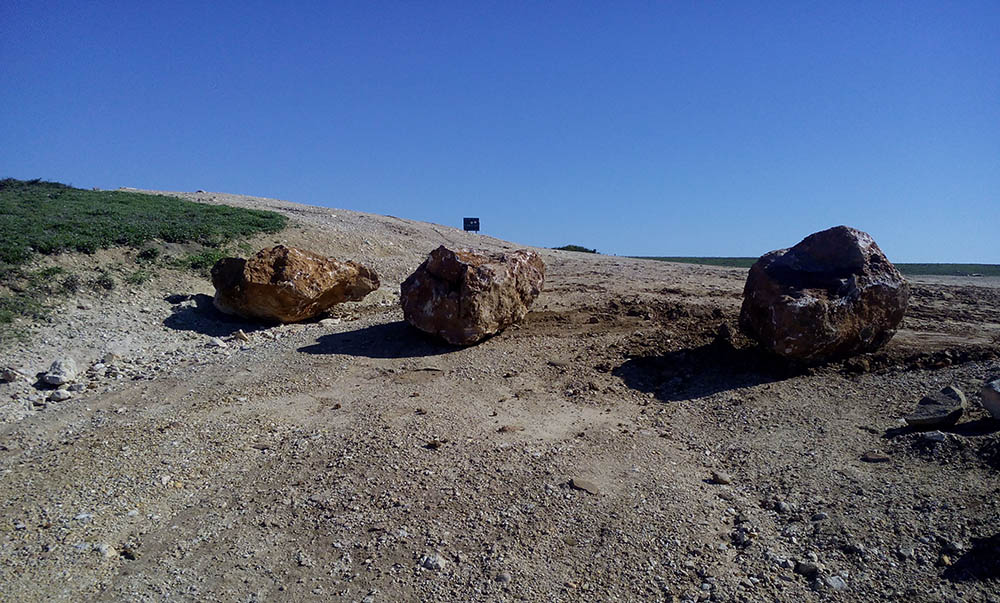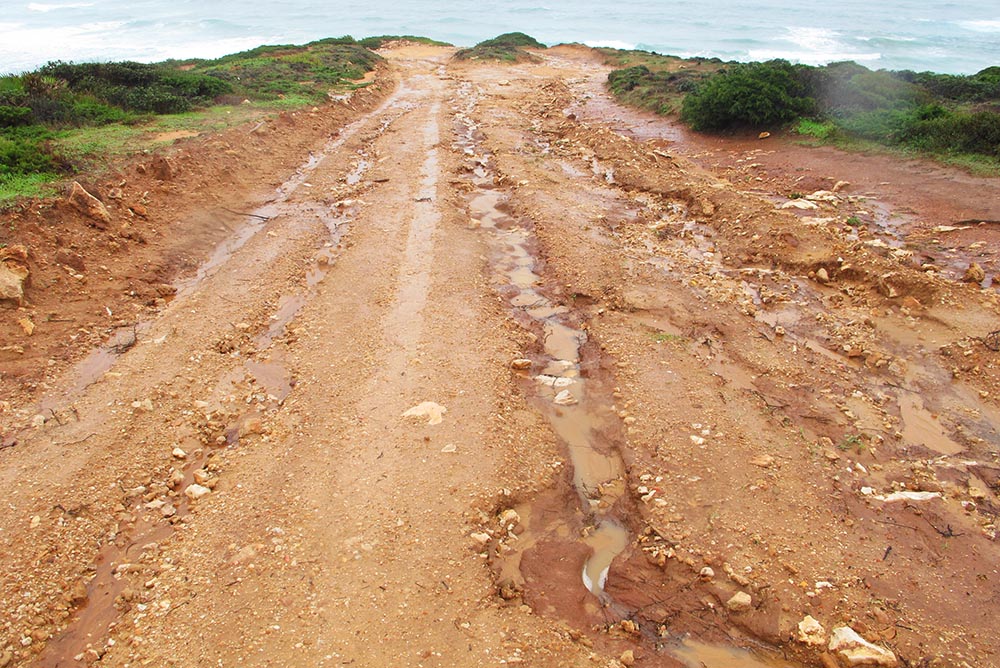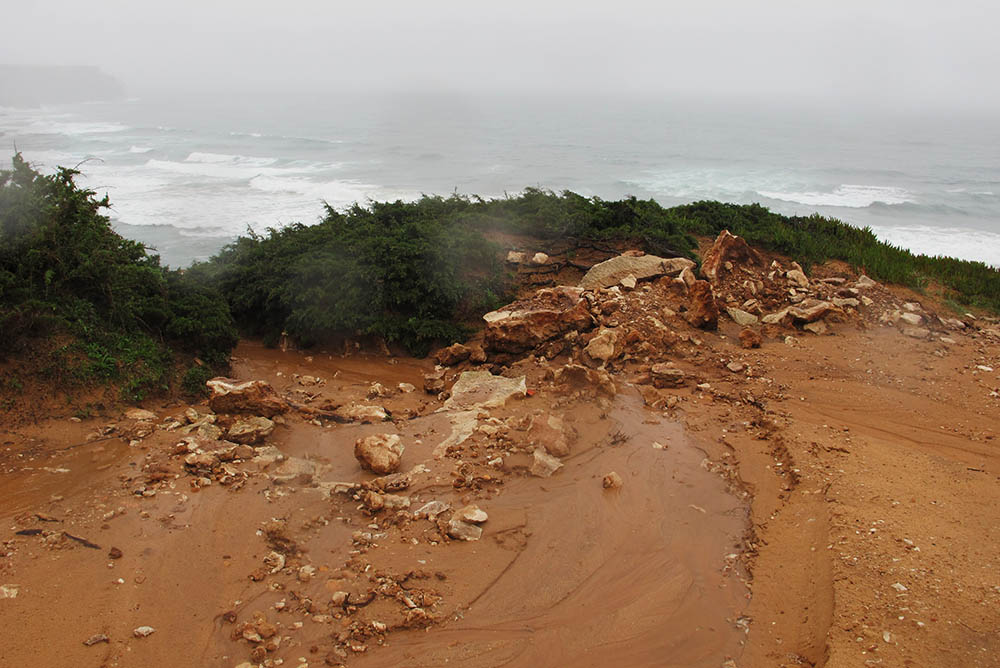 Large limestone rocks prevent access to the cliff, next to the Praia do Telheiro geosite. This is the first urgent measure that the Vila do Bispo Council has taken, after having been forced to do so by official entities, in order to safeguard that geosite "of recognized importance worldwide."
Large limestone rocks prevent access to the cliff, next to the Praia do Telheiro geosite. This is the first urgent measure that the Vila do Bispo Council has taken, after having been forced to do so by official entities, in order to safeguard that geosite "of recognized importance worldwide."
This measure aims to prevent automobile circulation in the last 150 meters corresponding to the quaternary cliff of high geological, floristic and landscape value, whose unstable formation also presents risks with regard to the safety of people and goods.
Another of the intervention phases involves the implementation of «natural engineering actions that allow the reduction of erosion and the restoration of vegetation cover», according to the opinion of the Institute for the Conservation of Nature and Forests (ICNF), dated 17 September.
The same opinion emphasizes that there should be only one lane for pedestrian access to the beach. These measures of vegetation recovery and erosion minimization will also be extended to parallel accesses that have emerged over the years and that “appear as wounds in the landscape”.
The Telheiro Defense Group, in a statement, reveals that some of the negative consequences caused by the action of the Vila do Bispo Council, in August, illegally opened a path to the edge of the cliff, a short distance away. from the geosite, allegedly to facilitate the access of lifeguards' vans closer to Praia do Telheiro.
 Thus, stresses that group, "recent rains have already caused the runoff of land and stones from the consolidated dune, broken at the end of August by the municipality." As the Praia do Telheiro Geosite is an area of high natural value, with the accumulation of almost all national and international protection statutes, «it is urgent to move forward with the renaturalization measure, preventing future damage», they argue.
Thus, stresses that group, "recent rains have already caused the runoff of land and stones from the consolidated dune, broken at the end of August by the municipality." As the Praia do Telheiro Geosite is an area of high natural value, with the accumulation of almost all national and international protection statutes, «it is urgent to move forward with the renaturalization measure, preventing future damage», they argue.
However, ICNF proposed to accompany the intervention, providing human resources and presenting technical solutions.
The Telheiro Defense Group itself, through one of its members, the architect Nicolau da Costa, presented “a set of technical solutions for the problem caused by the work”, at a meeting that took place on 21 October, with the president of the Chamber Adelino Soares.
After the clarifications requested by the General Inspectorate of the Ministries of Environment, Spatial Planning and Energy and of Agriculture and the Sea (IGAMAOT), ICNF also considered “that the works jeopardized the safeguarding of natural values and the high erosion that there occurs was enhanced by the interventions carried out».
In this context, ICNF ordered the City Council of Vila do Bispo that, being necessary to guarantee the safeguard of the valuables in presence, it “urgently proceeds to the delimitation of the parking area, in order to prevent the access of vehicles to the stretch of road that ends at the top of the cliff” and to intervene in “the entire area of steep slopes, in order to minimize the erosive effects” aggravated by the rains.
IGAMAOT continues to investigate the lack of requests for opinions from the competent authorities, by the municipality of Vila do Bispo, as well as some of the points of opinions issued by ICNF.
 The statement from the Telheiro Defense Group recalls that article 35 of the Municipal Master Plan (PDM) expresses the prohibition of all actions/activities on the cliffs, which lead to changes in the characteristics and disturbances of the environment, due to its rich flora , fauna, geology and landscape.
The statement from the Telheiro Defense Group recalls that article 35 of the Municipal Master Plan (PDM) expresses the prohibition of all actions/activities on the cliffs, which lead to changes in the characteristics and disturbances of the environment, due to its rich flora , fauna, geology and landscape.
Also point 5 of article 33 of the PDM, referring to the protection zones of the Sagres Biogenetic Reserve, stipulates the prohibition of vehicles outside existing roads and paths.
In the Planning Plan of the PDM, the access to Praia do Telheiro is not classified as a path, but as an access road to the coast. Both in this ordering letter, as in the recent military letters, “there is no marked path in the area intervened by the Chamber”, which undermines the autarchy's arguments.
The tears at the top of the cliff, now considered by the municipality as paths, began to be made, according to the GDT, “by the illegal passage of vehicles that, during the 90s, the strong period of smuggling in the region, used to travel there to collect goods".
In addition to safeguarding this important location, the new barrier and the renaturalization are considered by the Group as “important risk prevention measures, by safeguarding that no car, attracted by illegal access, ventures onto the cliff and slides to the bottom. With this measure, a step is taken in terms of prevention, avoiding accidents. Without any access to vehicles in the last 150 meters, material losses and personal accidents are minimized».
Praia do Telheiro is classified as Beach Type IV, "which corresponds to a beach associated with highly sensitive systems or that present limitations for bathing use, namely for reasons of user safety".
As a protected area, the promotion of access to beaches in this category is, underlines the Telheiro Defense Group, “an irreparable error, with the aggravation of increasing the degree of risk of accidents”. «Any accident in this place would become the responsibility of the authors of the work, namely the local authority», concludes that group.


















Comments